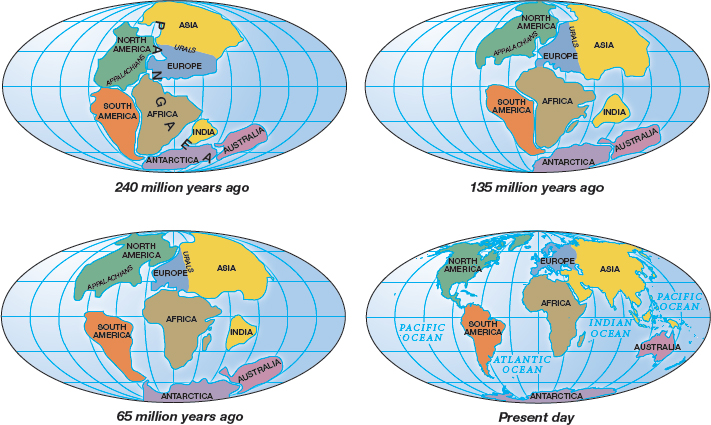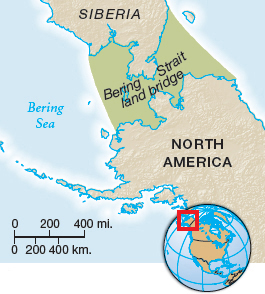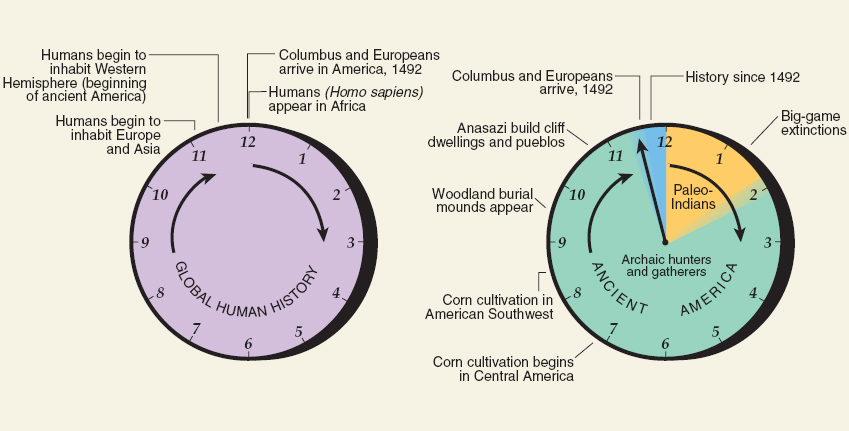African and Asian Origins
Printed Page 6
Human beings lived elsewhere in the world for hundreds of thousands of years before they reached the Western Hemisphere. They lacked a way to travel to the Western Hemisphere because millions of years before humans existed anywhere on the globe, North and South America became detached from the gigantic common landmass scientists now call Pangaea. About 240 million years ago, powerful forces deep within the earth fractured Pangaea and slowly pushed continents apart to their present positions (Map 1.1). This process of continental drift encircled the land of the Western Hemisphere with large oceans that isolated it from the other continents long before early human beings (Homo erectus) first appeared in Africa about two million years ago.

More than 1.5 million years after Homo erectus appeared, or about 400,000 BP, modern humans (Homo sapiens) evolved in Africa. All human beings throughout the world today are descendants of these ancient Africans. Slowly, over many millennia, Homo sapiens migrated out of Africa and into Europe and Asia, which had retained land connections to Africa, allowing ancient humans to migrate on foot. For roughly 97 percent of the time Homo sapiens have been on earth, none migrated across the enormous oceans isolating North and South America from the Eurasian landmass.

Two major developments made it possible for ancient humans to migrate to the Western Hemisphere. First, people successfully adapted to the frigid environment near the Arctic Circle. Second, changes in the earth’s climate reconnected North America to Asia.
By about 25,000 BP, Homo sapiens had spread from Africa throughout Europe and Asia. People, probably women, had learned to use bone needles to sew animal skins into warm clothing that permitted them to become permanent residents of extremely cold regions such as northeastern Siberia. A few of these ancient Siberians clothed in animal hides walked to North America on land that now lies submerged beneath the sixty miles of water that currently separate easternmost Siberia from westernmost Alaska. A pathway across this watery chasm opened during the last global cold spell — which endured from about 25,000 BP to 14,000 BP — when the sea level dropped and exposed a land bridge hundreds of miles wide called Beringia that connected Asian Siberia and American Alaska.
 The land bridge between Siberia and Alaska that was exposed by glaciation, allowing people to migrate into the Western Hemisphere.
The land bridge between Siberia and Alaska that was exposed by glaciation, allowing people to migrate into the Western Hemisphere.
Beringia
Siberian hunters roamed Beringia for centuries in search of mammoths, bison, and numerous smaller animals. As the hunters ventured farther and farther east, they eventually became pioneers of human life in the Western Hemisphere. Although they did not know it, their migrations revolutionized the history of the world.
Archaeologists refer to these first migrants and their descendants for the next few millennia as Paleo-Indians. They speculate that these Siberian hunters traveled in small bands of no more than twenty-five people. How many such bands arrived in North America before Beringia disappeared beneath the sea will never be known.
 Archaeologists’ term for the first migrants into North America and their descendants who spread across the Americas between approximately 15,000 BP and 13,500 BP.
Archaeologists’ term for the first migrants into North America and their descendants who spread across the Americas between approximately 15,000 BP and 13,500 BP.
When the first migrants came is hotly debated by experts. They probably arrived sometime after 15,000 BP. Scattered and inconclusive evidence suggests that they may have arrived several thousand years earlier. Certainly, humans who came from Asia — whose ancestors left Africa hundreds of thousands of years earlier — inhabited the Western Hemisphere by 14,000 BP.

CHAPTER LOCATOR
When and why do historians rely on the work of archaeologists?
How and why did humans migrate into North America?
Why did Archaic Native Americans shift to foraging and hunting smaller animals?
Page 7
How did agriculture influence Native American cultures?
What cultural similarities did native peoples of the Western Hemisphere share in the 1490s?
Why was tribute important in the Mexican empire?
Conclusion: How do we understand the worlds of ancient Americans?
 LearningCurve
LearningCurve
Check what you know.